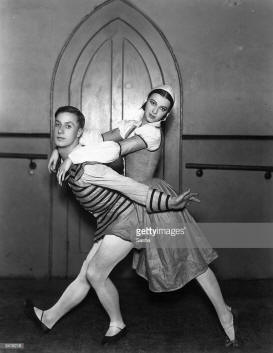

Queer Places:
Chelsea College of Arts, University of the Arts London (UAL), 16 John Islip St, Westminster, London SW1P 4JU, Regno Unito
23 Rope Walk, Rye TN31 7NA, UK
 William Chappell (27 September 1907 – 1 January 1994) was a
British
dancer, ballet designer and
director. He is most noted for his designs for more than 40
ballets or
revues,
including many of the early works of Sir
Frederick Ashton and Dame
Ninette de Valois. He was a longtime friend of
Terence Rattigan.
William Chappell (27 September 1907 – 1 January 1994) was a
British
dancer, ballet designer and
director. He is most noted for his designs for more than 40
ballets or
revues,
including many of the early works of Sir
Frederick Ashton and Dame
Ninette de Valois. He was a longtime friend of
Terence Rattigan.
The work of Broadway's gay and lesbian artistic community went on display in 2007 when the Leslie/Lohman Gay Art Foundation Gallery presents "StageStruck: The Magic of Theatre Design." The exhibit was conceived to highlight the achievements of gay and lesbian designers who work in conjunction with fellow gay and lesbian playwrights, directors, choreographers and composers. Original sketches, props, set pieces and models — some from private collections — represent the work of over 60 designers, including William Chappel.
Chappell was born in Wolverhampton, the son of theatrical manager Archie Chappell and his wife Edith Eva Clara Black (née Edith Blair-Staples).[1] After his parents separated, Chapell and his mother moved to Balham, London, where she pursued a career as a fashion journalist.[2] Edith's daughter by her first marriage, romantic novelist Hermina Black, Chappell's half-sister, was living nearby in Wandsworth.[3] The queer british artist Edward Burra arrived at Chelsea College of Art in 1921 at almost 16 years of age and became friends with fellow students Billy Chappell, Clover Pritchard (later de Pertinez) and Barbara Key-Seymer.
He did not take up dancing seriously until he was 17 when he studied under Marie Rambert,[4] whom he met through his friend Frederick Ashton.[2]
For two years Chappell and Ashton toured Europe with Ida Rubenstein's company under the direction of Massine and Nijinska. Chappell returned to London in 1929 to dance with Rambert's Ballet Club (later Ballet Rambert), the Camargo Society and Ninette de Valois's Vic-Wells Ballet becoming one of the founding dancers of British ballet. Throughout the 1930s he created more than 40 roles for Rambert and Vic-Wells including:
His flair as a designer was encouraged by Rambert and for this he is best remembered. In parallel with his dance career he designed more than 40 ballets or revues, including many of the early works of Ashton and de Valois including:
also
His designs for Les Patineurs remained in the repertory and his conception for Les Rendezvous, although frequently revised, continues. He brought his vast experience of ballet design to opera, musical theatre, revues and drama, as both director and designer.[4]
Chappell has been credited as directing the following productions:
In 1937, when Bunny Roger was still in his twenties, he established his popular fashion house, known as Neil Roger, in London’s Great Newport Street. At first he was planning to open it with William Chappell, but in the end he opened business alone.
At the outbreak of war in 1939, he was the first male dancer to join up, spending the duration of the war as a second lieutenant and entertaining the troops.[4]
In his book Studies in Ballet he describes an occasion in North Africa when his company had no transport and had to march to their destination about eighteen miles away. He used this story to illustrate the benefit of ballet training to legs and feet, allowing a middle-aged man to arrive fresher than men nearly half his age, who had only received the routine Army physical training. He also emphasised the importance of a long unbroken tradition and continuity in the training of male dancers. He was of the opinion that the war was a factor that had caused chaos in the Sadler's Wells Company and rendered valueless years of work. He contrasted the treatment of the ballet in England and in Russia, where male dancers were considered important enough in their work to be kept in it.
He was invited by writer and lecturer on dance Peter Brinson to take part in a series of 8 lectures on 'The Ballet in Britain' at Oxford University where he entertained an academic audience with his thoughts on problems of ballet design. Other speakers included Dame Ninette de Valois director of the Royal Ballet, Marie Rambert, Arnold Haskell, William Cole and Douglas Kennedy[11]
He retired to his home in Rye and died there after a long illness.[4]
My published books: